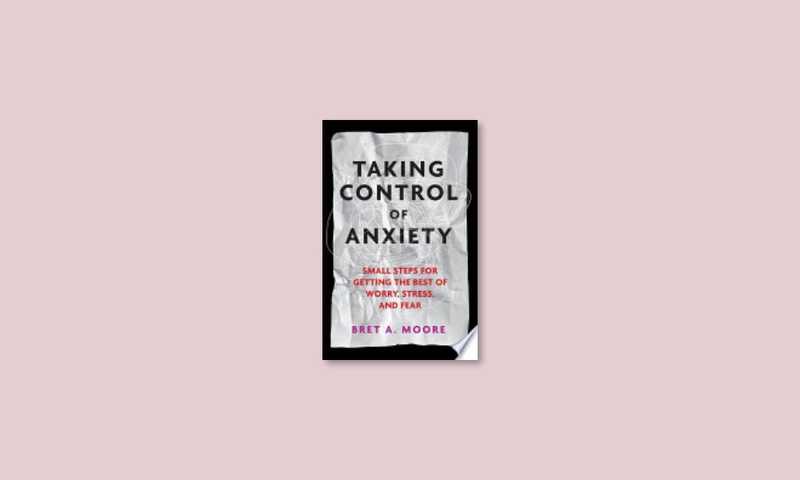
Taking Control of Anxiety by Bret A. Moore: A Guide to Reducing Stress and Anxiety in Your Life
Anxiety is a normal part of life that affects millions of people worldwide. It can manifest in various forms, such as excessive worry, irrational fears, or debilitating panic attacks. In his book "Taking Control of Anxiety," Bret A. Moore, a clinical psychologist, and former Army psychologist, provides practical advice and techniques to help individuals manage and overcome anxiety. This blog post will summarize some of the key insights and actionable strategies from the book, including understanding anxiety, identifying triggers, and implementing coping strategies. By understanding and employing these techniques, you can take control of your anxiety and live a more fulfilling life.
Understanding Anxiety
To effectively manage anxiety, it's essential to understand its nature and how it manifests in our lives. Here are some key points to consider:
- Anxiety is a natural and adaptive response to perceived threats, preparing us for action (fight or flight response).
- Anxiety disorders are different from everyday anxiety, as they involve excessive and persistent worry or fear that interferes with daily functioning.
- There are various types of anxiety disorders, including generalized anxiety disorder (GAD), panic disorder, social anxiety disorder, and specific phobias.
- Anxiety can cause a range of physical, emotional, and behavioral symptoms, such as rapid heartbeat, sweating, irritability, difficulty concentrating, and avoidance of anxiety-provoking situations.
Identifying Triggers
One of the first steps in managing anxiety is identifying the specific triggers that cause it. Here are some common triggers and tips for recognizing them:
- External triggers: These are events or situations in your environment that cause anxiety, such as work stress, relationship problems, or financial difficulties.
- Pay attention to the situations and events that precede your anxiety symptoms.
- Keep a journal to track your anxiety levels and the circumstances surrounding them.
- Internal triggers: These are thoughts or feelings that contribute to anxiety, such as negative self-talk, irrational beliefs, or low self-esteem.
- Monitor your thoughts and emotions to identify patterns that may be contributing to your anxiety.
- Challenge unhelpful thought patterns and replace them with more constructive alternatives.
Coping Strategies
Once you've identified the triggers of your anxiety, you can begin to implement coping strategies to help manage and reduce it. Here are some effective techniques to consider:
- Relaxation techniques: These methods can help calm your body and mind, reducing anxiety symptoms.
- Deep breathing exercises: Inhale slowly and deeply through your nose, filling your lungs, then exhale slowly through your mouth. Repeat this cycle for several minutes.
- Progressive muscle relaxation: Tense and then relax each muscle group in your body, starting with your toes and working your way up to your head.
- Visualization: Imagine yourself in a peaceful, calming environment, focusing on the sights, sounds, and sensations in this imagined setting.
- Cognitive restructuring: This approach involves changing the way you think about anxiety-provoking situations and replacing irrational beliefs with more realistic ones.
- Identify and challenge negative thoughts and beliefs, such as catastrophizing (believing that something terrible will happen) or overgeneralizing (believing that one negative event means that all similar events will also be negative).
- Replace these unhelpful thoughts with more balanced and rational alternatives, such as reminding yourself of your past successes or recognizing that not all situations are within your control.
- Exposure therapy: This technique involves gradually facing and confronting your fears in a controlled and systematic manner.
- Begin by creating a hierarchy of anxiety-provoking situations, ranking them from least to most anxiety-inducing.
- Gradually expose yourself to each situation on your hierarchy, starting with the least anxiety-provoking and working your way up to more challenging situations.
- Practice relaxation techniques and cognitive restructuring during exposure to help manage your anxiety.
- Lifestyle modifications: Making changes to your daily habits can also help reduce anxiety and improve your overall well-being.
- Regular exercise: Engage in at least 30 minutes of moderate-intensity physical activity most days of the week.
- Balanced diet: Eat a variety of nutrient-rich foods, focusing on fruits, vegetables, whole grains, lean proteins, and healthy fats.
- Adequate sleep: Aim for 7 to 9 hours of quality sleep each night, maintaining a consistent sleep schedule and creating a relaxing bedtime routine.
- Stress management: Incorporate relaxation techniques, social support, and time management strategies to help manage stress and reduce anxiety.
Seeking Professional Help
While many people can successfully manage their anxiety using self-help strategies, some may require professional assistance. If your anxiety is severe or persistent, consider seeking help from a mental health professional who can provide guidance and support tailored to your specific needs. This may involve therapy, medication, or a combination of both.
In conclusion, "Taking Control of Anxiety" offers practical advice and techniques for understanding, managing, and overcoming anxiety. By identifying triggers, employing coping strategies, and making lifestyle modifications, you can take control of your anxiety and live a more fulfilling, less anxious life. Remember, it's essential to be patient and persistent in your efforts, as overcoming anxiety is an ongoing process.